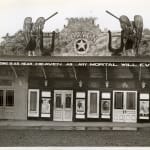[Holy City, California]
Collection of press photographs Documenting the Utopian Community in. the Santa Cruz Mountains, 1920s-60s
Silver prints (48)
11 x 8 to 8 x 6 inches
Most with various press notations and date stamps verso.
Most with various press notations and date stamps verso.
Sold
Further images
-
(View a larger image of thumbnail 1
)

-
(View a larger image of thumbnail 2
)

-
(View a larger image of thumbnail 3
)

-
(View a larger image of thumbnail 4
)

-
(View a larger image of thumbnail 5
)

-
(View a larger image of thumbnail 6
)

-
(View a larger image of thumbnail 7
)

-
(View a larger image of thumbnail 8
)

-
(View a larger image of thumbnail 9
)

-
(View a larger image of thumbnail 10
)

Holy City was a small community located in in the Santa Cruz mountains near the city of Los Gatos. It was founded in 1919 by White Supremacist, cult-like leader William...
Holy City was a small community located in in the Santa Cruz mountains near the city of Los Gatos. It was founded in 1919 by White Supremacist, cult-like leader William E. Riker, who envisioned it as a religious utopia. Riker, also known as "Father Riker," "The Comforter" "The Professor" and "The Emancipator" aimed to establish a self-sufficient community based on his religious beliefs. He promoted a mix of Christian teachings, Eastern philosophy, and his own interpretations of spirituality. He also espoused numerous racist and White supremacist ideologies, and ran for governor of California on such a platform.
Holy City was designed to serve as a place where his followers could live and practice their faith. To pay for this, he also fashioned it as a tourist trap for passing motorists. The community included a hotel, a theater, a radio station, a dance hall, a peep show, and a zoo. Riker also constructed a large stone tower called the "Tower of the Sun," which served as a prominent landmark in the area.
Despite its initial popularity and attention, Holy City faced challenges over the years. Riker's controversial teachings, as well as financial troubles, led to a decline in the community's influence and membership. In the 1940s, Riker's leadership came under scrutiny, and Holy City began to lose its followers. As well, the rerouting of Highway 17 to bypass Holy City let to a substantial decline in tourism, and a sharp loss of revenue. Financial difficulties eventually led to Riker losing control of the community in 1960. In 1966, at the age of 93, Riker converted to Catholicism.[6]
The collection presented here is made up of three groups; the first, comprising 22 prints (1928-29), shows Holy City in it's hey-day, with portraits of Riker, views of the town, and interiors of the hotel; the second group includes 7 prints (1942-44) pertaining to Riker's trial for accusations of Sedition after he allegedly incited service men not to fight in WWI, due to his support for Hitler, whom he called "the second Martin Luther;" and the third group which contains 13 prints and 6 contact sheets (1961-66) portraying a 94-year old Riker, shown following the community's decline in population and Holy City's disincorporation in 1959.
Holy City was designed to serve as a place where his followers could live and practice their faith. To pay for this, he also fashioned it as a tourist trap for passing motorists. The community included a hotel, a theater, a radio station, a dance hall, a peep show, and a zoo. Riker also constructed a large stone tower called the "Tower of the Sun," which served as a prominent landmark in the area.
Despite its initial popularity and attention, Holy City faced challenges over the years. Riker's controversial teachings, as well as financial troubles, led to a decline in the community's influence and membership. In the 1940s, Riker's leadership came under scrutiny, and Holy City began to lose its followers. As well, the rerouting of Highway 17 to bypass Holy City let to a substantial decline in tourism, and a sharp loss of revenue. Financial difficulties eventually led to Riker losing control of the community in 1960. In 1966, at the age of 93, Riker converted to Catholicism.[6]
The collection presented here is made up of three groups; the first, comprising 22 prints (1928-29), shows Holy City in it's hey-day, with portraits of Riker, views of the town, and interiors of the hotel; the second group includes 7 prints (1942-44) pertaining to Riker's trial for accusations of Sedition after he allegedly incited service men not to fight in WWI, due to his support for Hitler, whom he called "the second Martin Luther;" and the third group which contains 13 prints and 6 contact sheets (1961-66) portraying a 94-year old Riker, shown following the community's decline in population and Holy City's disincorporation in 1959.
![[Holy City, California], Collection of press photographs Documenting the Utopian Community in. the Santa Cruz Mountains, 1920s-60s](https://artlogic-res.cloudinary.com/w_1600,h_1600,c_limit,f_auto,fl_lossy,q_auto/artlogicstorage/dollc/images/view/601b2c0ffbc2a6d3db2196e5afc9269bj/daniel-oliver-holy-city-california-collection-of-press-photographs-documenting-the-utopian-community-in.-the-santa-cruz-mountains-1920s-60s.jpg)
![[Holy City, California], Collection of press photographs Documenting the Utopian Community in. the Santa Cruz Mountains, 1920s-60s](https://artlogic-res.cloudinary.com/w_1600,h_1600,c_limit,f_auto,fl_lossy,q_auto/artlogicstorage/dollc/images/view/79c6e579b72f961c91a595da1132c302j/daniel-oliver-holy-city-california-collection-of-press-photographs-documenting-the-utopian-community-in.-the-santa-cruz-mountains-1920s-60s.jpg)
![[Holy City, California], Collection of press photographs Documenting the Utopian Community in. the Santa Cruz Mountains, 1920s-60s](https://artlogic-res.cloudinary.com/w_1600,h_1600,c_limit,f_auto,fl_lossy,q_auto/artlogicstorage/dollc/images/view/dfc3a5150ce547e6728516d78dd00e25j/daniel-oliver-holy-city-california-collection-of-press-photographs-documenting-the-utopian-community-in.-the-santa-cruz-mountains-1920s-60s.jpg)
![[Holy City, California], Collection of press photographs Documenting the Utopian Community in. the Santa Cruz Mountains, 1920s-60s](https://artlogic-res.cloudinary.com/w_1600,h_1600,c_limit,f_auto,fl_lossy,q_auto/artlogicstorage/dollc/images/view/156755ed128437bee3243712fbed7894j/daniel-oliver-holy-city-california-collection-of-press-photographs-documenting-the-utopian-community-in.-the-santa-cruz-mountains-1920s-60s.jpg)
![[Holy City, California], Collection of press photographs Documenting the Utopian Community in. the Santa Cruz Mountains, 1920s-60s](https://artlogic-res.cloudinary.com/w_1600,h_1600,c_limit,f_auto,fl_lossy,q_auto/artlogicstorage/dollc/images/view/33b2eed60ec19a7c083f5776f48d4074j/daniel-oliver-holy-city-california-collection-of-press-photographs-documenting-the-utopian-community-in.-the-santa-cruz-mountains-1920s-60s.jpg)
![[Holy City, California], Collection of press photographs Documenting the Utopian Community in. the Santa Cruz Mountains, 1920s-60s](https://artlogic-res.cloudinary.com/w_1600,h_1600,c_limit,f_auto,fl_lossy,q_auto/artlogicstorage/dollc/images/view/25bfc9c665ad29a852e59c8dd62756b9j/daniel-oliver-holy-city-california-collection-of-press-photographs-documenting-the-utopian-community-in.-the-santa-cruz-mountains-1920s-60s.jpg)
![[Holy City, California], Collection of press photographs Documenting the Utopian Community in. the Santa Cruz Mountains, 1920s-60s](https://artlogic-res.cloudinary.com/w_1600,h_1600,c_limit,f_auto,fl_lossy,q_auto/artlogicstorage/dollc/images/view/383985acb56bc18e90caf1b42b4aec39j/daniel-oliver-holy-city-california-collection-of-press-photographs-documenting-the-utopian-community-in.-the-santa-cruz-mountains-1920s-60s.jpg)
![[Holy City, California], Collection of press photographs Documenting the Utopian Community in. the Santa Cruz Mountains, 1920s-60s](https://artlogic-res.cloudinary.com/w_1600,h_1600,c_limit,f_auto,fl_lossy,q_auto/artlogicstorage/dollc/images/view/3f91b11a6866112eef4325bb8d6e1776j/daniel-oliver-holy-city-california-collection-of-press-photographs-documenting-the-utopian-community-in.-the-santa-cruz-mountains-1920s-60s.jpg)
![[Holy City, California], Collection of press photographs Documenting the Utopian Community in. the Santa Cruz Mountains, 1920s-60s](https://artlogic-res.cloudinary.com/w_1600,h_1600,c_limit,f_auto,fl_lossy,q_auto/artlogicstorage/dollc/images/view/025cd9b9ca0d8613272be0e106d329c3j/daniel-oliver-holy-city-california-collection-of-press-photographs-documenting-the-utopian-community-in.-the-santa-cruz-mountains-1920s-60s.jpg)
![[Holy City, California], Collection of press photographs Documenting the Utopian Community in. the Santa Cruz Mountains, 1920s-60s](https://artlogic-res.cloudinary.com/w_1600,h_1600,c_limit,f_auto,fl_lossy,q_auto/artlogicstorage/dollc/images/view/913224f62646bf8c22b67d75511521b7j/daniel-oliver-holy-city-california-collection-of-press-photographs-documenting-the-utopian-community-in.-the-santa-cruz-mountains-1920s-60s.jpg)